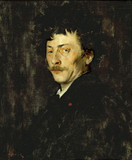William Merritt Chase was the foremost portraitist and among the most popular artists and teachers of his day in New York. In 1861 his family moved to Indianapolis, where he received technical training from a local artist, Barton S. Hays (1826-1914). After briefly serving in the navy in 1867, he returned to Indianapolis. By 1868, when he left for New York, he was already considered an accomplished still-life painter. In New York he studied drawing at the National Academy of Design. In 1871 he moved to Saint Louis, where he continued to support himself as a still-life painter.
Commissions from a group of patrons in Saint Louis enabled him to enroll in 1872 in the Royal Academy of the Fine Arts in Munich. After studying with Alexander von Wagner (1838-1919), Chase was chosen in 1874 to study with the academy’s most distinguished professor, Karl von Piloty (1826-1886), under whom he developed a forcefully realistic style based upon the baroque masters. At the same time he was intimately associated with his progressive German classmates and the leaders of the large colony of American students, with whom he painted in a more expressive, sketchy style. After visiting Venice, Chase returned to New York in 1878 to accept a teaching position at the Art Students League.
In New York he maintained an elaborate studio, quickly becoming one of the most successful and conspicuous figures among the younger artists. He was elected a member of the Society of American Artists in 1878, and he served as its president in 1880 and then again for ten years beginning in 1885. He was a founding member of the Society of Painters in Pastel in 1883. In 1887 Chase was elected an associate member of the National Academy of Design and in 1890 an academician. In 1905 he was elected a member of the independent exhibiting group, Ten American Painters.
During the 1880s and after 1903 he traveled to Europe almost every year, keeping in close touch with new stylistic currents. A fashionable portraitist, he was also successful as a landscape and genre painter and later as a still-life painter. Chase was active as a teacher, especially at the Art Students League and the Pennsylvania Academy of the Fine Arts in Philadelphia and at his Chase School in New York and his Shinnecock Summer School of Art near Southampton, Long Island, where he taught plein air painting. Intermittently for ten years, beginning in 1903, he taught summer classes at various places in Europe and once in Carmel, California.
BIBLIOGRAPHY
Katharine Metcalf Roof, The Life and Art of William Merritt Chase (1917; reprint, New York: Hacker, 1975), with introduction by Alice Gerson Chase, list of paintings by location § Indianapolis, John Herron Art Museum, Chase Centennial Exhibition, exh. cat., 1949, with text by Wilbur D. Peat, catalogue of known works § Abraham David Milgrome, "The Art of William Merritt Chase," Ph.D. diss., University of Pittsburgh, 1969, with Chase lectures, student reminiscences, catalogue of works, chronology, bibliography § Santa Barbara, University of California, Art Gallery, and others, William Merritt Chase, exh. cat., 1964, with text by Ala Story § Ronald G. Pisano, A Leading Spirit in American Art: William Merritt Chase, 1849-1916, (Seattle: Henry Art Gallery, University of Washington, 1983), with chronology and bibliography, published in conjunction with an exhibition held at the Henry Art Gallery, University of Washington, Seattle, and Metropolitan Museum of Art, New York, 1983-84.




